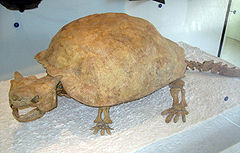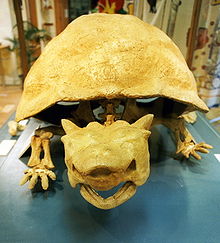- Meiolania
-
Meiolania
Temporal range: Oligocene–Holocene
Meiolania platyceps skeleton, American Museum of Natural History Scientific classification Kingdom: Animalia Phylum: Chordata Class: Reptilia Order: Testudines Suborder: Cryptodira Family: †Meiolaniidae Genus: †Meiolania
Owen, 1886Species - †M. brevicollis
- †M. platyceps
- †M. mackayi
Meiolania ("small roamer") is an extinct genus of cryptodire turtle from the Oligocene to Holocene, with the last relict populations at New Caledonia which survived until 2,000 years ago.
The animal was rather large, measuring 2.5 metres (8.2 ft) in length, making it the second-largest known nonmarine turtle or tortoise, surpassed only by Colossochelys atlas from Asia, which lived in the Pleistocene. It lived in Australia and New Caledonia. Remains have also been found on the island of Efate in Vanuatu, associated with settlements from the Lapita culture.[1] Meiolani turtles fed on plants. Its surviving relatives are the cryptodire turtles of South America. The Meiolania specimens which were once living on New Caledonia and Lord Howe Island were much smaller than their giant relatives from the Australian continent.
When the first fossil remains (a vertebra) were found, they were originally thought to be from a large monitor lizard, similar to, but smaller than Megalania, so the genus was named accordingly. Later, when more remains were found, it was realized that the "small roamer" was actually a turtle, and not a lizard. Synonyms include Miolania and Ceratochelys.
Contents
Anatomy
 Meiolania by Heinrich Harder
Meiolania by Heinrich Harder
Meiolania had an unusually shaped skull that sported many knob-like and horn-like protrusions. Two large horns faced sideways, giving the skull a total width of 60 centimetres (2.0 ft), and would have prevented the animal fully withdrawing its head into its shell. The tail was protected by armored 'rings', and sported thorn-like spikes at the end.[2] The body form of Meiolania may be viewed as having converged towards those of dinosaurian ankylosaurids and xenarthran glyptodonts.
See also
References
- ^ White, A. W.; Worthy, T. H.; Hawkins, S.; Bedford, S.; Spriggs, M. (2010-08-16). "Megafaunal meiolaniid horned turtles survived until early human settlement in Vanuatu, Southwest Pacific". Proc. Natl. Acad. Sci. USA 107 (35): 15512–15516. doi:10.1073/pnas.1005780107. http://www.pnas.org/content/107/35/15512.short. Retrieved 2011-08-30.
- ^ Palmer, D., ed (1999). The Marshall Illustrated Encyclopedia of Dinosaurs and Prehistoric Animals. London: Marshall Editions. p. 67. ISBN 1-84028-152-9.
- Barry Cox, Colin Harrison, R.J.G. Savage, and Brian Gardiner. (1999): The Simon & Schuster Encyclopedia of Dinosaurs and Prehistoric Creatures: A Visual Who's Who of Prehistoric Life. Simon & Schuster.
External links
- Meiolania platyceps Owen (The Australian Museum; photo)
- Mikko's Phylogeny Archive on Cryptodira
Categories:- Extinct turtles
- Prehistoric reptiles of Australia
- New Caledonia Holocene fauna
- Pleistocene reptiles
- Pliocene reptiles
- Oligocene reptiles
- Miocene reptiles
- Meiolaniidae
- Holocene extinctions
- Megafauna of Australia
Wikimedia Foundation. 2010.

